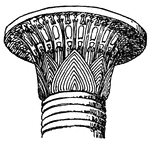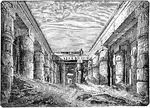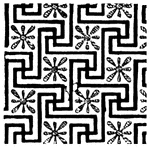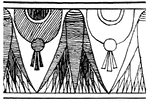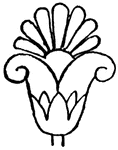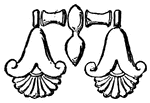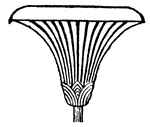
Sacred Ibis
Found throughout Africa, the sacred (or white) ibis was revered by the ancient Egyptians.
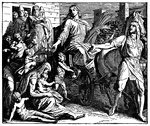
Joseph Collects Wheat as Governor of Egypt in Preparation for the Famine
"48 And he gathered up all the food of the seven years which were in the land of Egypt, and laid up…

Joseph Greets His Father Jacob and His Family
"And Joseph made ready his chariot, and went up to meet Israel his father, to Goshen; and he presented…
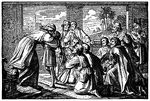
Joseph Reveals Himself to His Brothers and Embraces Benjamin
"Then Joseph could not refrain himself before all them that stood before him; and he cried, Cause every…
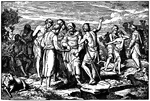
Joseph's Brother Sell Him into Slavery after Pulling Him Out of the Cistern
"Come, and let us sell him to the Ishmaelites, and let not our hand be upon him; for he is our brother,…

Judgment of the Dead
An illustration of an Egyptian hieroglyphic depicting the judgment of the dead. "An ape-assessor scourages…

The Judgment of the Dead
"Showing the weighing of the heart of the deceased in the scales of truth."—Myers, 1904

Karnak
Karnak, Egypt, which comprises of a vast mix of decayed chapels, temples, and other buildings. It was…

Karnak
Karnak is a vast grouping of ruined temples, chapels, pylons and other buildings located mear Luxor,…

Central Avenue, Hall of Columns, Karnak
"The hall measures 170 feet deep by 329 feet broad. Its roof was supported by a central avenue of 12…

Temple of Karnak
"Karnak is a village in Egypt built on the site of Thebes, on the bank of the Nile, and renowned for…

Khufu
A Pharaoh of Ancient Egypt. He reigned from 2589 to 2566 BC, and is known for being the builder of the…
Egyptian Kitchen - Roasting a Goose
"A cook roasting a goose; he holds the spit with one hand, and blows the fire with a fan held in the…

Egyptian Kitchen
"Scene in Egyptian kitchen, showing use of a large rope to support a sort of hanging shelf." -Hill,…

The Lentil Plant
This illustration shows a lentil plant. Lentils are the round, flat seeds of a small leguminous plant…

Illumination of a Koran Link Border
The illumination of a Koran link border is a scroll design of leaves connected like a chain. This design…

Lotus-Palmette
The peculiar horn-like volutes are probably representations of the third and fourth sepals of the lotus-calyx.
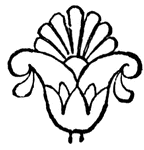
Lotus-Palmette with Tabs
Lotus-palmette with tabs consists of a group of diverging leaves or petals springing from between two…
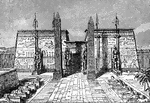
Luxor Temple
Luxor Temple is a large Ancient Egyptian temple complex located on the east bank of the River Nile in…

Egyptian Man's Costume
This is an Egyptian Man's costume that was typically worn during the Old Kingdom. It consists of a wrap…

Egyptian Man's Costume
This is an Egyptian Man's costume that was worn by priests during the 5th Dynasty. It shows a man wearing…

Egyptian Man's Costume
This is an Egyptian Man's costume that was typically worn during the 5th Dynasty. It consists of a triangular…
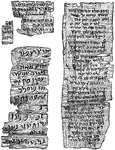
Ancient Hebrew Manuscript
"A papyrus of the first century A.D., containing the Ten Commandments. It was discovered in Egypt."—Webster,…

Sarcophagus of Menkera
"The third pyramid on the ridge of Gizeh was built by Menkera, a successor of Khafra and fourth or fifth…

Merneptah
The fourth ruler of the Nineteenth Dynasty of Ancient Egypt, reigning from 1213 to 1203 BC.

Fruit Gathering Monkeys
"Monkeys appear to have been trained to assist in gathering fruit; and the Egyptians represent them…

Moses is Found by Pharaoh's Daughter as Miriam Watches
"And when she could not longer hide him, she took for him an ark of bulrushes, and daubed it with slime…

mummy
"Mummy. Another striking religious custom was the embalming of the dead. It was thought that the soul…

Mummy Coffin
An illustration of a mummy coffin. The mummy was typically wrapped in linen and placed many nesting…

Egyptian musician
"That the Egyptians paid great attention to the study of music and had arrived at a very accurate knowledge…
Egyptian Needle
"The Egyptian needles were of the following fashion. They wrote with a reed, or rush, many of which…

Nose ring
Israeli women would often wear rings not just on their wrists, but on their noses and ears and ankles.

Osirid Pier
In several Egyptian temples there are square or rectangular piers fronted with colossal sculptured figures…

Osiris
"Osiris was worshipped as the god of the sun, the source of warmth, life, and fruitfulness, in addition…
Early Egyptian Pictures
"Early Egyptian Pictures. Ploughing, breaking clods, and sowing."—Gordy, 1912

Pillar and beam
"Columns are largely employed in the architecture of Egyptian temples. They are of various forms." —D'Anvers,…






